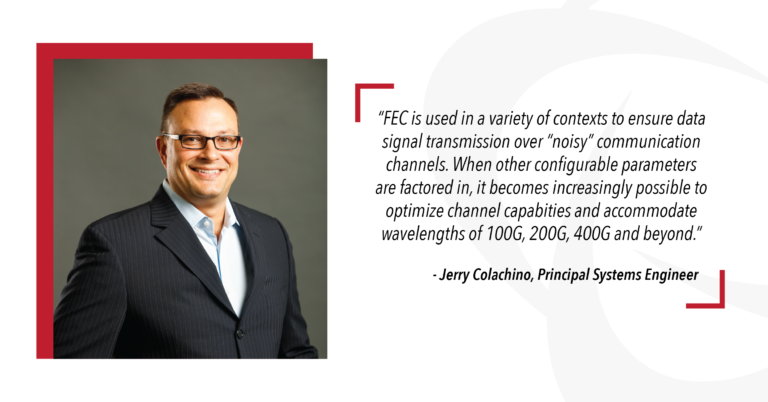
Precision OT in Lightwave: Talking FEC, 100G Networks and Beyond

When it comes to transmitting data signals, a variety of factors can distort them or, worse yet, completely prevent them from reaching their destinations. In a perfect world, the data we transmit through various communications channels would always arrive complete and untarnished – exactly as we send it. In reality, this just isn’t the case. Our Principal Systems Engineer, Jerry Colachino, examined the subject of Forward Error Correction (FEC) in the context of next-generation fiber optic networking for Lightwave recently. Specifically, he wrote about the role FEC deployment has in optimizing channel capacities for accommodating wavelengths in 100G, 200G and 400G networks.
When it comes to transmitting data accurately, network operators can simultaneously send both original data and redundant bits or error correcting codes (ECCs) across the same paths to the receiver. But here we get to a key trade-off. Since reliable codes are complex and involve many redundant bits, they take up a lot of space in the transmission channel. This means lowered data transmission rates even though signal-to-noise ratios (SNRs) get improved. For longer-haul fiber optic network operators, though, improving optical SNRs is the name of the game as this directly influences how far wavelengths can travel before needing generation.
That’s where FEC deployments in fiber optic networks comes in. By encoding the original data/message prior to transmission with redundant data, network operators can reduce optical SNRs, thereby increasing wavelength travel distance significantly. It’s basically all about maximizing the capacity and even data transmission rates of existing infrastructure while staying economic.
Remember the Shannon limit – the theoretical maximum information transfer rate for a channel with a given base noise level? Well, it turns out that by using FEC algorithms to create ECCs, fiber optic network administrators can get their operations really close to that limit. Jerry notes that although ECCs come as either block or convolutional codes, decoded through hard-decision and soft-decision algorithms respectively, using both together can achieve performances of within roughly 1 to 1.5dB of the Shannon limit.
As we enter the era of next-gen, ultra high speed, high capacity networks, soft-decision forward error correction (SD-FEC) solutions are now growing in popularity. Although they are somewhat more expensive than hard-decision algorithms because they produce byte overheads of around 20%, the gains are substantial. Jerry states that for a 100G network, even a 1 to 2 dB gain leads to 20% to 40% greater reach.
Offering a new way to balance enhanced gain with overhead, software-defined optical networking (SDON) is becoming an attractive option. Here, SDON offers operators the ability to configure FEC cores and switch between the two overheads associated with hard- and soft-decision algorithms. In any case, with modern engineering advances, network operators get what they need: the ability to optimize channel capacities for 200G and 400G wavelengths. Read Jerry’s full article here and let us know your thoughts!






